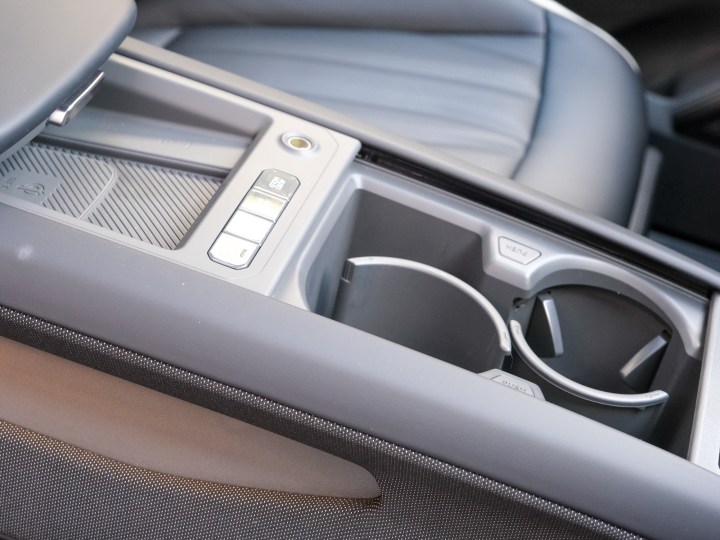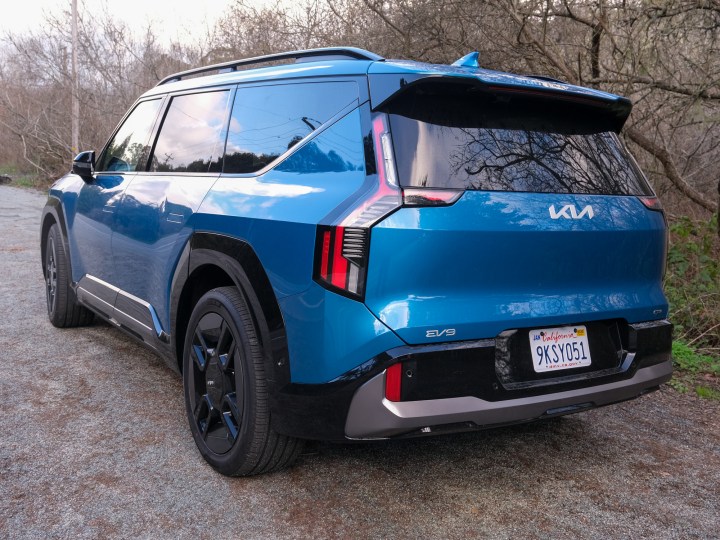
“The Kia EV9 is a great buy no matter which model you go for.”
- Stylish design
- Luxurious, spacious interior
- Good performance
- Reasonable price
- Low range on entry-level models
The world of electric SUVs hasn’t been known for its variety. If you’re in the market for a full-size SUV and want something electric, you’re more or less limited to a car like the Rivian R1S — a car that’s far from affordable. But if there were any company that could start to finally bring affordable options to the market, it would be Kia. The Kia EV9 has had a long and much-hyped launch, and finally, the electric SUV is available for purchase.
The EV9 has a ton of fanfare to it, and it’s easy to see why: It offers a modern design, it’s built on the same platform as the much-loved EV6, and it can fit seven people in some configurations. Sure, it’s perhaps not the ultra-affordable option that some were hoping for — but it does still push the electric SUV into a much lower price tier. At the starting price of $54,900, there’s really no competition just yet.
But the lack of competition isn’t reason alone to buy something. We’ve been testing the Kia EV9 GT-Line to find out if the new electric SUV truly lives up to the hype. Spoiler alert — the EV9 is easily ready for the competition that will inevitably come out.
Design and interior
Overall, the Kia EV9 looks kind of like a cross between the much-loved Telluride and the Kia EV6. To be sure, the EV9 is big and blocky, but I kind of like the style. It has a sculpted body, with angular lines across the side and rear, and while quite large, the EV9 does have a sporty feel to it.

On the front, the EV9 sports Kia’s new “Digital Tiger Nose,” which is essentially an evolution of the Tiger Grille that adorned previous-generation Kia cars. You’ll get angular headlights with a kind of pixel design that looks very modern. This pixel design is only available on higher-end models, however you will get the angular headlights no matter which model you go for. Frankly, you’re probably not missing much without the pixel lights, but it’s a nice added bonus if you get a higher-end model.
The rear is quite sporty-looking, too. Angular taillights stretch down the back of the EV9 in a way that’s very reminiscent of modern Volvos. A small spoiler follows on from the roofline of the car, which helps add to the sportiness.
The interior of the EV9 looks very premium, at least in our range-topping GT-Line model. The EV9 in general can be purchased in either six- or seven-seater configurations: the former with captain’s chairs in the middle, the latter with a bench seat. Only the Light and Wind models can be outfitted for seven passengers. Our review model came with the two captains chairs, which are motorized and perhaps even more comfortable than the front seats. The EV9 also has USB-C ports for charging throughout the cabin of the car, including for both second- and third-row passengers, and there’s a large storage bin for the second-row passengers, which is a nice touch. Finally, passengers get their own climate zone, which is always handy.

While I spent most of my time in the driver’s seat, I did sit in the passenger seats for a while to get an idea of how spacious they were. Good news: There’s a ton of room in any seat you sit in, within reason. Sure, the third row does get cramped with the second row all the way back, and like any three-row SUV, the third row will be more comfortable for children than anyone else. However I was impressed with the level of comfort on offer, even in the third row.
Storage space is ample too, depending on whether you keep the third row of seats up or not. With the third row of seats up, there’s 20.2 cu-ft of space, however with the third row down, you’ll get 43.5 cu-ft of storage space. There’s also a frunk, which gets smaller if you opt for all-wheel-drive. The GT-Line is an AWD model, and there was still enough space to store a few grocery bags.
Overall, the interior of the EV9 is spacious and comfortable, which genuinely helpful features throughout.
Tech, infotainment, and driver assist
Kia has made a serious effort to adopt modern technology in its cars — with a few caveats. I quite like the infotainment experience in the Kia EV9 — however part of that is due to the fact that the car supports CarPlay. Thankfully, the EV9 supports CarPlay through a wireless connection, unlike the EV6. That allowed me to simply plop my phone down on the charging pad, and get started — without having to mess around with cables.

One aspect of infotainment that I really did appreciate was the fact that the EV9 has a dedicated climate display and physical climate controls. This means that both the driver and passengers can easily control climate settings like fan speed and temperature, or then dive into the dedicated display for more advanced controls. Unfortunately, that dedicated display is a little hidden to the driver by the steering wheel — and difficult to access for the passenger. But, it could be worse — by hiding climate controls deep into settings, for example.
There are some great driver-assist features built into the car too, even standard. No matter what model you buy, you’ll get basics like blind-spot monitoring and emergency braking. If you get the GT-Line, you’ll get an advanced cruise control with lane-centering, and unlike other cars, you won’t be forced to keep your hands on the wheel. It worked quite well, and while it’s really only useful on the highway, it is one step further towards better self-driving tech.

I do wish that some of the best driver-assist features weren’t reserved for more expensive models. For example, you’ll only get the camera-based blind-spot monitor and the Surround View Monitor in the Land AWD or GT-Line trims. It’s worth double-checking that the features you want are available on the model you plan on buying.
Driving experience
Driving the Kia EV9 is a blast. It may be huge, but it still benefits from the immediate response that has become characteristic of an electric vehicle. It’s much heavier than the EV6, and as such not quite as fast, but you’d be hard-pressed to find a faster SUV that doesn’t cost a whole lot more.

The EV9 comes in single- or dual-motor configurations, powering the rear-wheel or all-wheel-drive powertrains, respectively. In the base EV9 Light RWD, you’ll get a 215-horsepower motor, however you can get up to 379 horsepower with the dual-motor configurations. Eventually, there will be a GT model that will step things up to 576 horsepower, too.
The overall drive of the EV9 was smooth, yet responsive. The car takes bumps and potholes in stride, with the drive arguably being a little more luxurious than sporty, despite the fast acceleration. That fits the car though — an SUV is a family car, and it’s built for comfort. You don’t want to feel the road the same way you might a smaller, sportier car.

I always prefer driving a car with one pedal, if and when possible. The EV9 comes with Kia’s iPedal system, which can slow the car to a stop when you take your foot off the pedal. Unfortunately, you can’t set iPedal to be the default setting — so you’ll have to switch to it every time you turn the car on. Apart from iPedal, there are three levels of regenerative braking, and the car will remember your setting between drives.
Range and charging
The Kia EV9 offers anywhere from not-so-great to a pretty good range, depending on the model you buy. Range varies from 230 miles on the Light RWD model, up to 304 miles on Light Long Range RWD model, or 280 miles on the Wind and Land AWD models. None of these figures are particularly impressive, though 280 miles is a whole lot better than 230, obviously. Our GT-Line model puts a little more power into the wheels, lowering range to 270 miles.

Thankfully, however, when you pull up to the right charge, you’ll juice up pretty quickly. The Kia EV9 supports 350kW charging, making it one of the fastest-charging cars out there. If you can manage to find a charging station that supports 350kW, you’ll get from 0% to 80% in a little over 20 minutes, which is very impressive. Unfortunately, companies like Electrify America are still building out these super-fast charging stations, and the EV9 doesn’t yet come with an NACS port.
How DT would configure this car
The Kia EV9 is a great buy no matter which model you go for, at least with the current paucity of competition in this space. If you’re looking to spend as little as possible for an electric three-row SUV, you will love the base Kia EV9 Light. However, if you can stretch your budget a little, we recommend doing so for perks like longer range.
The Wind AWD model is probably the way to go for most buyers. It steps up the performance with a second motor and has a larger battery that delivers 280 miles of range. It also comes with a more luxurious interior thanks to the second-row captain’s chairs, plus it adds features like heated front seats and more driver-assist features. Most buyers do not need to upgrade to the GT-Line model that we reviewed — however, those that want the most tech-heavy experience may consider it for things like the hands-free driver-assist and Surround View Monitor.



